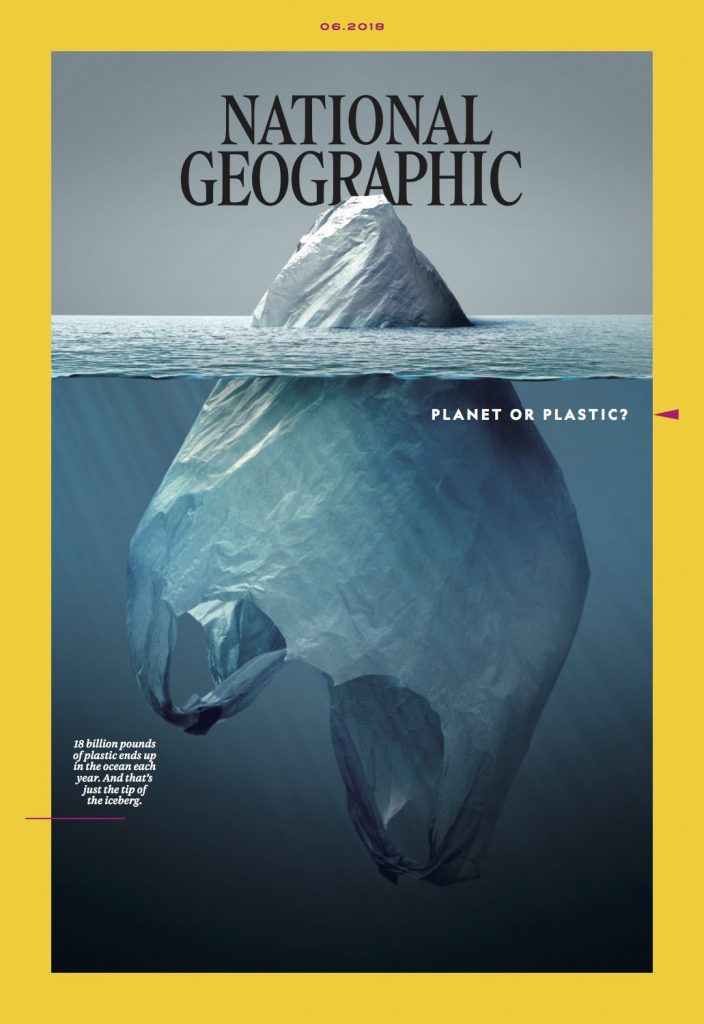08 Jun When the Image IS the Story
I was recently floored when I laid my eyes on the image adorning the June cover of National Geographic. It was one of those images that took a few seconds to sink in and once it did, I couldn’t take my eyes off of it. Here’s the interesting backstory on it if you’re interested. The cover and cover story kicked off a new initiative by the magazine, called Planet or Plastic, to raise awareness for and fund studies on the negative impact plastic is having on the planet.

Cover and image courtesy of National Geographic
National Geographic has built a reputation on impactful cover images, and this image, in particular, encapsulates the potent power an image can possess to engage readers and illicit an emotional response. But, given my and the business communication world’s infatuation with storytelling, when I looked at this image, my brain went right to the question of whether an image like this can tell a story, all on its own. I have my own take on that (which I’ll share a bit later) but first, I wanted to hear what some of the amazing storytelling experts we’ve spoken with in the past had to say about it:
Kristin Luck, Serial Entrepreneur, Growth Hacking Consultant and Storyteller:
The idea of images as a storytelling vehicle is indisputable in my opinion. Dating back to the Neolithic era, you can see clear examples of this in Tassili n’Ajjer in south-east Algeria, where there are over 15,000 rock engravings depicting large wild animals, cattle herds and humans engaging in activities such as hunting and dancing. Each of these images tells a story. Likewise, if you look at the world of performance art, and particularly the work of Marina Abramovic, you’ll see how sitting across from a stranger, in complete silence (as Abramovic did in her MOMA exhibition “The Artist is Present”) can tell a story without any words. Sometimes, the most powerful stories require just a tiny bit of imagination and suspension of disbelief. Not every story can be told with words.
Carla Johnson, Storyteller, Speaker and Prolific Author:
Can a single image tell a story? If it’s the right image, absolutely. This is what visual art through the ages has always done. Consider Michelangelo’s “The Creation of Adam”, Picasso’s La Guernica or Wood’s “American Gothic.” These are all examples of powerful images that tell a story. And just like written stories, the more times we revisit them, the more they reveal to us.
Can a single image tell the whole story? No. The purpose behind an image is to provoke emotion so we pay attention. When that happens, we pay attention to the emotion, and how we perceive the story based on what the image means to us. But even complex images can’t convey all that a story entails.
Paul Smith, Business Storytelling Speaker and Trainer, Author of Lead with a Story and Sell with a Story:
Can a picture tell a story? Of course it can. If you’ve ever seen a Normal Rockwell painting on the cover of a Saturday Evening Post magazine, you’ve seen what that looks like. But not just any picture tells a story. For example, I don’t know if the (National Geographic) picture tells a story. I think it communicates an analogy — the analogy of the iceberg that only 10% of a problem is visible while the other 90% is hidden. But that’s an analogy, not a story.
For a picture to tell a story, the single image must not only make it clear what’s going on at the moment the picture was taken, but what must have happened before and what will likely happen after. That’s what makes it a story — you can infer the beginning, middle, and end of the story from the picture in the middle of the story. (Or, it could be at the end.)
Interesting perspectives by each of our experts with points I hadn’t even considered when I first laid eyes on this image. And now my two cents… I tend to agree with our experts that an image can definitely tell a story. But unlike a story we read or hear, I think an image requires a lot more of its viewer to put the pieces of the story together. And those pieces can be interpreted and assembled differently depending on each viewer’s perceptions, experiences and memories. When I view this cover image, I’m reminded of the times I used to go pier fishing with my family in the Outer Banks of North Carolina. I’d look out from the pier and see nature’s vastness and beauty, but would then look down and see all the floating trash piled up next to the pier. This is engrained in the story of this image for me. The story that comes to mind for you when you look at this image may be totally different. Do only some images tell stories? Do images only tell part of a story? Do images tell different stories to different viewers? Tell us what you think at #BeEngagious or add a comment on our LinkedIn page.

Sorry, the comment form is closed at this time.